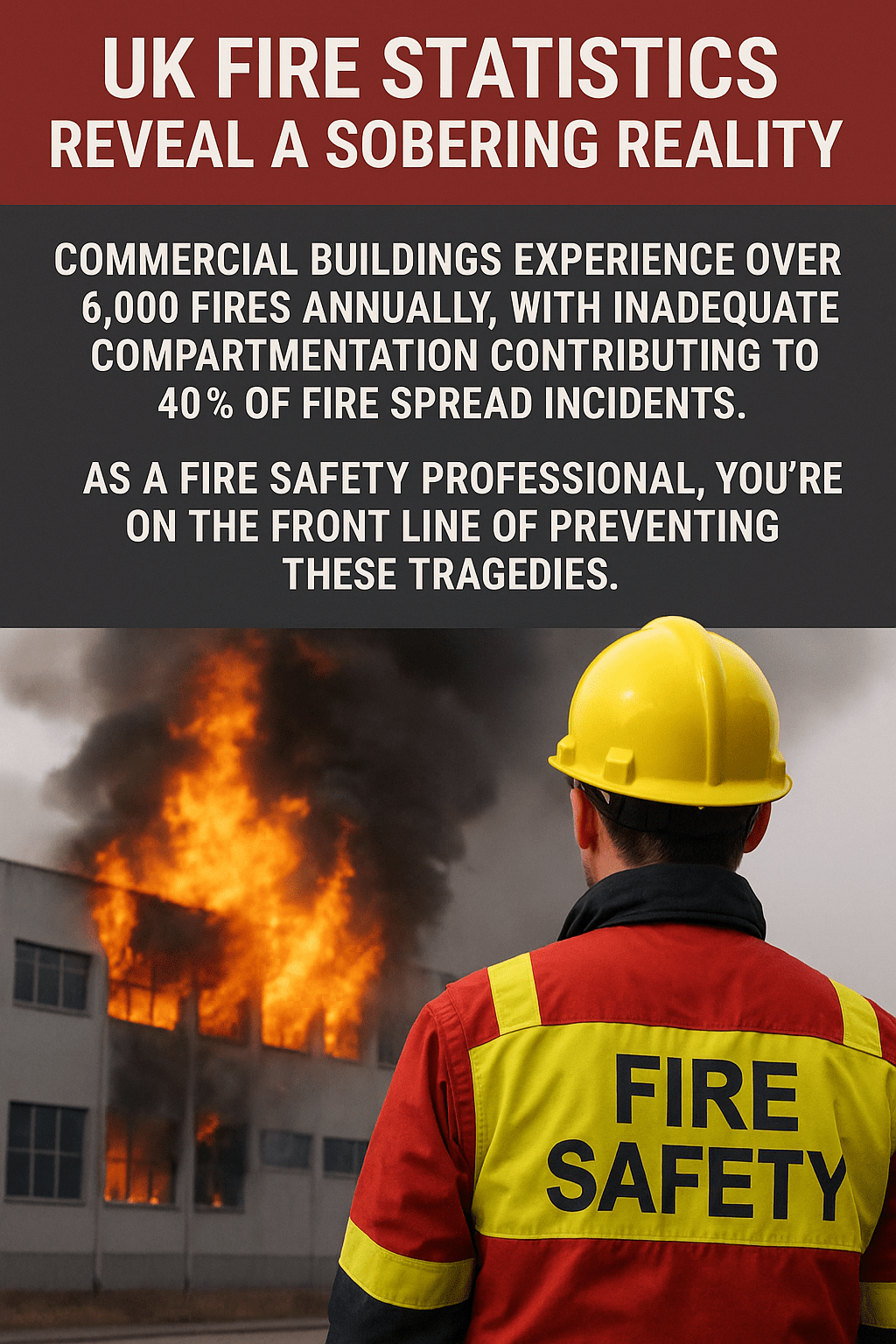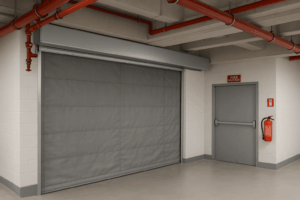The Facts Behind BS 8524 and BS EN 16034 in the UK Fire Curtain Industry
Picture this: In 2019, a devastating fire at a Manchester shopping centre could have claimed dozens of lives. Instead, strategically placed fire curtains activated within seconds, containing the blaze to a single retail unit and allowing 800+ people to evacuate safely. This real-world example demonstrates why understanding fire curtain standards isn’t just regulatory compliance—it’s about saving lives.
UK fire statistics reveal a sobering reality: commercial buildings experience over 6,000 fires annually, with inadequate compartmentation contributing to 40% of fire spread incidents. As a fire safety professional, you’re on the front line of preventing these tragedies.

BS 8524 serves as the UK’s primary standard for active fire curtains, providing rigorous testing protocols specifically designed for British building conditions and regulatory requirements. Despite the IFC withdrawal in June 2023, BS 8524 remains your go-to framework for UK compliance.
BS EN 16034, the European standard, covers broader fire resistance products but lacks some of the specialised testing rigour that makes BS 8524 uniquely suited for UK applications.
In 2024, navigating both standards effectively determines whether your fire curtain installations meet the evolving regulatory landscape while ensuring maximum occupant protection.
Firstly, let’s talk about passive fire protection.
What is Passive Fire Protection
Passive fire protection (PFP) refers to a set of building materials and systems designed to contain or slow the spread of fire and smoke within a structure, in accordance with building standards. Unlike active fire protection systems, such as sprinklers or alarms, passive fire protection does not require activation or human intervention to function. Instead, it relies on the inherent properties of fire-resistant materials and construction techniques to maintain the integrity of walls, floors, and ceilings, thereby compartmentalising a building and providing critical time for occupants to evacuate and for emergency responders to arrive. Common elements of passive fire protection include fire-resistant walls, doors, floors, and coatings, as well as firestopping materials used to seal openings and joints in fire-rated assemblies.
Responsibilities in Passive Fire Protection in the UK
In the UK, passive fire protection responsibilities are governed by building regulations and fire safety laws, ensuring buildings are designed to limit fire and smoke spread. Building owners, architects, and contractors must comply with these regulations by selecting fire-resistant materials and installing fire barriers and compartmentation systems correctly. Regular inspections and maintenance are essential to keep these measures effective. Any building modifications must consider fire safety impacts. The Regulatory Reform (Fire Safety) Order 2005 assigns the ‘responsible person’ the duty to manage fire safety risks, including maintaining passive fire protection.

Understanding the Two Standards: BS 8524 vs BS EN 16034
When specifying active fire curtains, you’ll encounter two key standards that serve different but complementary purposes. Understanding their distinctions ensures you select products that meet both regulatory requirements and performance expectations.
| Aspect | BS 8524 | BS EN 16034 |
|---|---|---|
| Scope | UK-specific standard exclusively for active fire curtains | European harmonised standard covering fire doors, shutters, and curtains |
| Application | Dedicated testing protocols for active fire curtain systems | General fire-resisting products with CE marking requirement |
| Durability Testing | Mandatory 500 cycle operation testing before fire testing | Limited durability testing requirements |
| Testing Specificity | Product-specific test methods tailored to fire curtain operation | Generic testing approach across multiple product types |
| Certification Status | UK “gold standard” for active fire curtains | Provides CE marking for European market compliance |
BS 8524 represents the UK’s definitive standard for active fire curtains, incorporating rigorous durability testing that simulates real-world operational demands. This standard requires 500 operational cycles before fire testing, ensuring your fire curtains maintain integrity throughout their service life.
BS EN 16034 serves as the harmonised European standard enabling CE marking, but lacks the application-specific testing depth that fire curtains require.
“Industry bodies recommend that fire curtain specifications include BS 8524 certification to complement BS EN 16034 where CE marking is used, ensuring both regulatory compliance and operational reliability.”
Leading industry organisations, including ASFP and Sweco recommend you specify both standards when procuring fire curtains. This dual approach ensures CE marking compliance while maintaining the enhanced performance assurance that BS 8524’s specialised testing provides.
Current Regulatory Status and Compliance Requirements
Following IFC’s withdrawal from BS 8524-1 certification in June 2023, you face a complex regulatory landscape requiring careful navigation. Despite this withdrawal, your existing valid third-party certifications from relevant certification bodies to BS 8524-1 remain fully recognized and compliant, provided you maintain design integrity and ISO 9001 accreditation.
Key compliance requirements you must understand:
- Valid BS 8524 certifications issued before IFC withdrawal retain legal standing
- Manufacturers must demonstrate continuous ISO 9001 quality management compliance
- No design modifications permitted without recertification
- Documentation verification through reputable Notified Bodies is essential
Post-Brexit Construction Products Regulation has created additional complexity in the certification landscape. You must ensure your fire curtain specifications align with UK market requirements, as EU certifications may not automatically transfer.
Industry guidance confirms continuing validity:
Sweco explicitly states that “BS 8524 remains the recognised standard for fire curtain systems in the UK market.” Similarly, ASFP guidance emphasises that properly certified systems under BS 8524 continue meeting regulatory requirements.
The City of London Building Control and OPSS (Office for Product Safety and Standards) maintain their recommendation for BS 8524 certification, providing you with regulatory certainty despite marketplace confusion.
Critical action required:
You must verify all documentation directly with Notified Bodies rather than relying on manufacturer claims. Market misinformation has proliferated since the IFC withdrawal, making independent verification essential for compliance assurance.
When specifying fire curtains, ensure your chosen systems maintain valid BS 8524 certification with documented ISO 9001 compliance. This approach protects your projects from regulatory non-compliance while navigating the transitional certification environment effectively.
Technical Performance and Testing Protocols
When evaluating fire curtain performance, you’ll encounter significantly different testing rigour between BS 8524 and BS EN 16034 standards. BS 8524 demands comprehensive 500-cycle durability testing before fire resistance evaluation, ensuring your curtains withstand repeated operational stress that mirrors real-world conditions.
Key Performance Criteria Comparison
| Criteria | BS 8524 | BS EN 16034 |
|---|---|---|
| Fire Resistance | Up to 240 minutes | Up to 240 minutes |
| Temperature Threshold | 1000°C (cellulosic curve) | 945°C (standard curve) |
| Smoke Leakage | <200 m³/h·m² at 25Pa | <200 m³/h·m² at 25Pa |
| Durability Testing | 500 cycles mandatory | Limited requirements |
| Deployment Speed | <60 seconds specified | Not specified |
Testing Procedures You Should Expect
Step 1: Durability assessment through 500 operational cycles
Step 2: Deployment speed verification under controlled conditions
Step 3: Fire resistance testing in accredited furnaces
Step 4: Smoke containment measurement at specified pressure differentials
Step 5: Warning mechanism functionality validation
BS 8524 uniquely addresses deployment speed requirements, mandating that curtains descend within 60 seconds while maintaining structural integrity. You’ll also find comprehensive warning mechanism testing, including acoustic and visual alerts that BS EN 16034 doesn’t specify.
UK-accredited facilities like Warringtonfire and BRE Global conduct these assessments using standardised furnaces and measurement equipment. Your certification process involves witnessed testing, with results documented in detailed reports showing temperature curves, smoke leakage rates, and deployment times.
When specifying fire curtains, you should prioritise BS 8524 compliance for applications requiring proven durability and reliable deployment mechanisms, as these critical safety features aren’t adequately addressed in BS EN 16034 protocols.
Practical Implementation Challenges
You face significant obstacles when implementing both IFC and EN 1634-1 standards simultaneously. As a fire safety professional, you must navigate these key challenges:
Manufacturer Compliance Burdens:
- Dual testing requirements increase your product certification costs by 40-60%
- You must maintain separate documentation systems for each standard
- Your supply chain complexity doubles when sourcing compliant products
Market Confusion Impacts: Since IFC’s withdrawal, you’re encountering inconsistent product labeling and unclear compliance documentation. Many manufacturers still reference obsolete IFC certifications, requiring you to verify current EN 1634-1 compliance through Notified Bodies rather than trusting manufacturer claims.
Installation Certification Differences: You’ll find that installer certification requirements vary significantly. While IFC-trained technicians may lack EN 1634-1 credentials, forcing you to either retrain staff or source new contractors.
Maintenance Protocol Variations: Your maintenance schedules must account for different inspection intervals—EN 1634-1 typically requires more frequent testing than legacy IFC protocols.
Real-World Example: A London high-rise project recently faced six-month delays when you discovered that half the fire curtains carried only IFC certification. The contractor had to source EN 1634-1 compliant alternatives, increasing costs by £200,000.
Practical Navigation Strategy: You should establish a dual-verification process: first, confirm EN 1634-1 compliance through official Notified Body documentation, then cross-reference with manufacturer specifications. This approach reduces your project risk while ensuring regulatory compliance across different jurisdictions.
Building Safety Act 2022 and Future Implications
The Building Safety Act 2022 fundamentally transforms how you approach fire curtain compliance through stringent “Golden Thread” documentation requirements under Section 156. As a fire safety professional, you must now maintain comprehensive digital and physical records throughout your building’s lifecycle.
New Requirements You Must Meet:
- Complete documentation trail – Every fire curtain installation, maintenance, and modification must be recorded
- BS 8524-1 and BS EN 16034 certification – All fire curtains require proper standards compliance verification
- Competency verification – Only qualified personnel can specify, install, and maintain fire safety systems
- Digital integration – Physical records must link to digital building information systems
- Regular updates – Documentation must reflect real-time building changes and fire safety arrangements
Section 156 Fire Safety Duties Impact
You’re now legally obligated as a Responsible or Accountable Person to demonstrate continuous compliance. This means your fire curtain specifications must include detailed performance data, installation certificates, and maintenance schedules that integrate seamlessly with building management systems.
Enhanced Accountability Measures
The Act significantly increases enforcement powers and financial penalties for non-compliance. You face potential unlimited fines if your fire curtain documentation fails to meet Golden Thread standards. This requires you to implement robust quality assurance processes and regular competency assessments.
Future implications: Expect increased scrutiny during inspections, mandatory digital record integration, and stricter contractor qualification requirements. Your procurement processes must now prioritise suppliers who can provide comprehensive documentation packages supporting long-term compliance obligations.
Professional Recommendations and Best Practices
As a fire safety professional, you should implement these evidence-based practices for optimal fire curtain compliance:
Priority Standards:
- Prioritise BS 8524 as your primary standard for UK fire curtain installations – it represents the gold standard for British applications
- Complement with BS EN 16034 certification to ensure comprehensive European compliance coverage
- Never rely solely on manufacturer claims – always verify certifications through accredited Notified Bodies
Specification Guidelines:
- Specify both standards in your project documentation to maximise regulatory acceptance
- Verify installation conditions match certified parameters exactly
- Document compliance evidence throughout the project lifecycle
Ongoing Compliance:
- Maintain existing valid certifications that meet original approval conditions
- Schedule regular compliance audits with qualified third-party assessors
- Update specifications when regulations change or products are modified
Take Action: Review your current fire curtain specifications against both BS 8524 and BS EN 16034 requirements. Ensure your procurement processes mandate third-party verification rather than manufacturer self-certification.
Industry best practice confirms that dual-standard compliance provides the strongest regulatory foundation, while BS 8524 certification ensures alignment with UK-specific fire safety requirements.
Read here for a guide on the difference between fire curtains and fire shutters.
View our range of fire shutters here.
